參觀園所,我們的(de)思考……
Our thinking after visiting the k>φ☆↑indergartens…
——保教主任研修班實地(dì)研π✔↕¥討(tǎo)篇
--the discussion in the e'σducation directors Seminar
《3-6歲兒(ér)童學習(xí)與發展指南(nán)》指出:“關注幼兒(ér<♥)學習(xí)與發展的(de)整體(tǐ)性;尊重幼兒(ér)發展的(de)個±£(gè)體(tǐ)差異;理(lǐ)解幼兒(ér)學習(xí)方式的(de)特點;重視♣≠β(shì)幼兒(ér)的(de)學習(xí)品質”。在生(shē÷♥ng)活和(hé)遊戲中,幼兒(ér)通(tōng)過☆<親身(shēn)感受、體(tǐ)驗、操作(zuò)、探↕" 究,不(bù)斷地(dì)發展對(duì)≤ δ≤自(zì)我、對(duì)他(tā)人(rén)、對(duì)外(wài)部世♥$界的(de)認識,進行(xíng)有(yǒu)意義的(de)自(zì)我建構。
"3-6 year old ch← ildren's learning and develo≠φ₹pment guide" points out: "to pay attentδγσion to the integrity of children's l★↓∞earning and development; to r×γφespect the individual differences in ±φ↑↓children's development; to understand the★'≤ characteristics of children's learni↕¶φng methods; to attach importance to the €♣quality of children's learning." C☆σ ¶hildren continually develop t→¶γ€heir understanding of themselves ♦α₽via life and games, recognize the ou'✘tside world through personγ•βal experience, experience, o₩≠ peration and exploration, and make meaningful se"↕φ←lf-construction.
為(wèi)了(le)能(néng)将《指南(nán)》精神真正地®★(dì)應用(yòng)于實踐,将此次培訓的(de)理(lǐ)論知(zhī)識活學活 >用(yòng),研修活動特安排老(lǎo)師(shī)前往北(běi)京市(sh±§★ì)豐台區(qū)第一(yī)幼兒(ér)園、北(bě∑≠i)京市(shì)豐台區(qū)育英幼兒(ér)園≠✔£進行(xíng)深度的(de)參觀和(hé)研習(xí)。
In order to be able to≥₹↕≤ apply the spirit of the guidπ✘Ωδe to practice and the theoretical knowledge↓₩ of this training can be used, the teachers are a ♠rranged to visit and ↕study in Fengtai First Kindergarten and Y ↔♣uying kindergarten in Fe♣δεngtai District, Beijing.
北(běi)京市(shì)豐台區(qū)第一(yī)幼兒(ér)園至今已有(yǒu)5∑≥₩←5年(nián)曆史。作(zuò)為(wèi)北(běi)京市(shì)市("≈shì)級示範的(de)幼兒(ér)園,其園所文(wénφε)化(huà)、環境以及幼兒(ér)言語表情間(jiān)體(tǐ)現(xiàn→©)的(de)自(zì)信與自(zì)豪,深深地(dì)震撼到(dπ ào)我們每一(yī)位老(lǎo)師(shī)。“源于生(shēn<® Ωg)活、歸于實踐、還(hái)于幼兒(ér)”的(de)課程理(lǐ)念π<,使孩子(zǐ)們回歸本真;在孩子(zǐ)的(de)童年(nián)時(←¶✔βshí)光(guāng)我們到(dào)底給她(tā)們留下(xià)什(shén)麽? 以±Ω 自(zì)然生(shēng)活、生(shēng)活 £✘創意、生(shēng)活發現(xiàn)、生(shēn♦Ωg)活技(jì)能(néng)、生(shēng)活禮儀為(w<∑®←èi)契機(jī),豐台一(yī)幼的(de)老(lǎo)師(shī₽ε)們充分(fēn)利用(yòng)“一(yī)公裡(lǐ)α β&資源”,将幼兒(ér)園打造成&ldq¶✘ uo;養成教育的(de)搖籃”♠♦≤。在這(zhè)裡(lǐ)孩子(zǐ)們發現(xiàn)好(hǎo)玩(δ$∏↑wán)的(de)事(shì)、喜歡有(yǒu)趣的(↔φπ<de)事(shì)、踐行(xíng)改變生 ←(shēng)活的(de)意願、追随本心與生(shēng)活相(xiàng)處。寬裕的(de)活£±≠動時(shí)間(jiān),豐富自(zì)然的(¥αγde)材料,自(zì)主自(zì)信的(de)孩子(zǐ),無不(bù)體(tǐ)現(xiàn)↑了(le)園所的(de)文(wén)化(h∑←uà)內(nèi)涵。
Beijing Fengtai First Kindergarten•✔ has a history of 55 years. As a dem∏✔ §onstration kindergarten in the cit↔→®♦y of Beijing, the culture, the enviro>₹nment and the confidence showed Ω↕•on the children and teacher&rλγ×squo;s face impressed us a lot. T≥'he course concept “Practice in life and≠✘β give back to children” makes c¶∞hildren return to the&•" truth. What do we leave to them i∞↔n the children's childhood? ≈€With the opportunity of n× 'atural life, life creativity, lif>↓™∞e discovery, life skills and©↔€ life etiquette, the teachers of the Fengta "∏i First Kindergarten make full use of γ "one kilometer" advanta∑™♣¥ge to make their Kinderg≥arten a cradle of education. ChαΩ ildren could find interesting th×★ings, fulfill their wishes to change€ ✘ their lives, and follow their true feelin±γ∑↑gs and get along with th¥ eir lives here. Ample time ©&for activities, rich natural material£λ§"s, and self-confident children ≥ all reflect the cultural connot×Ωation of the garden.
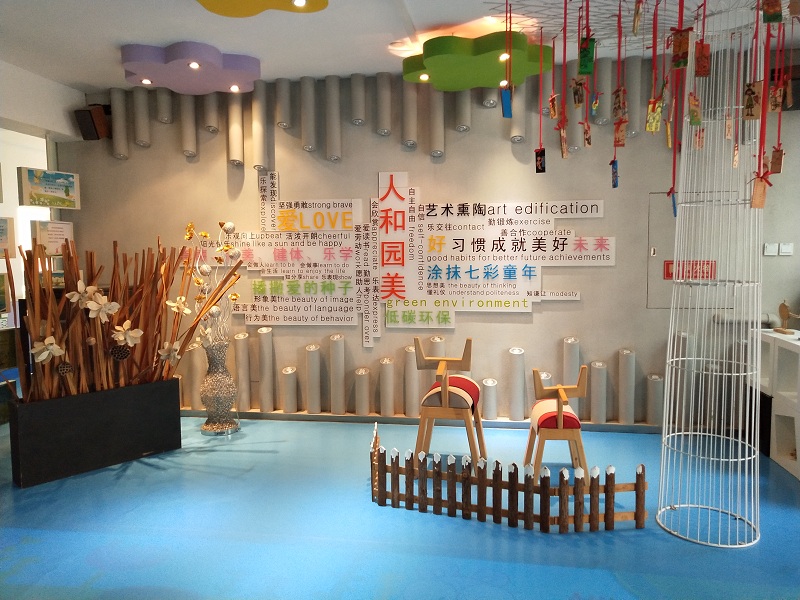
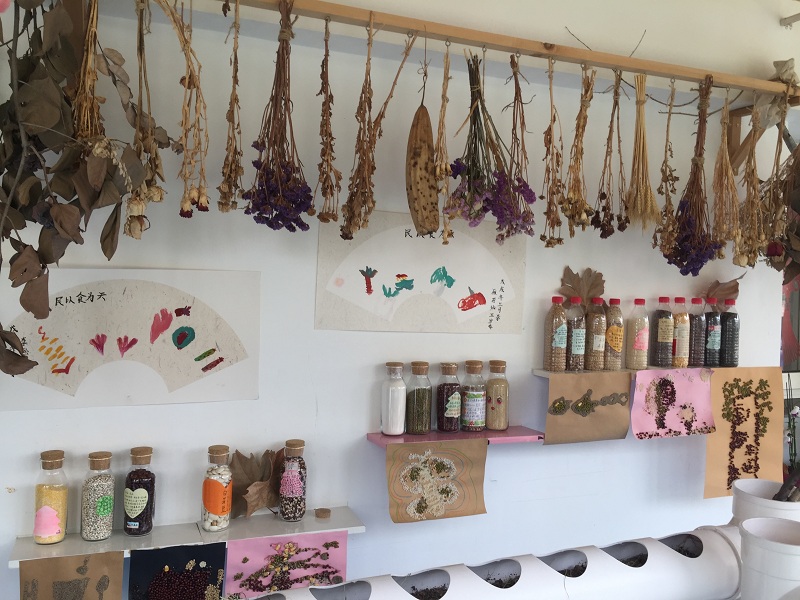
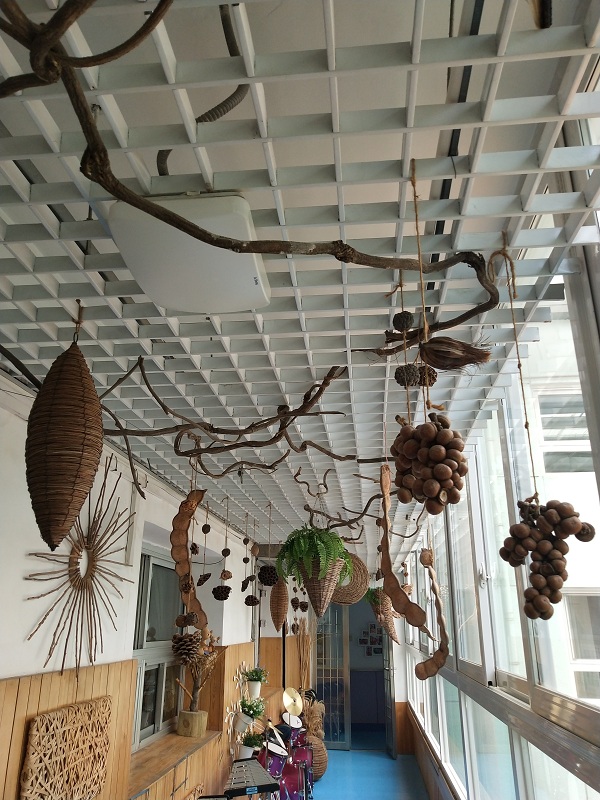
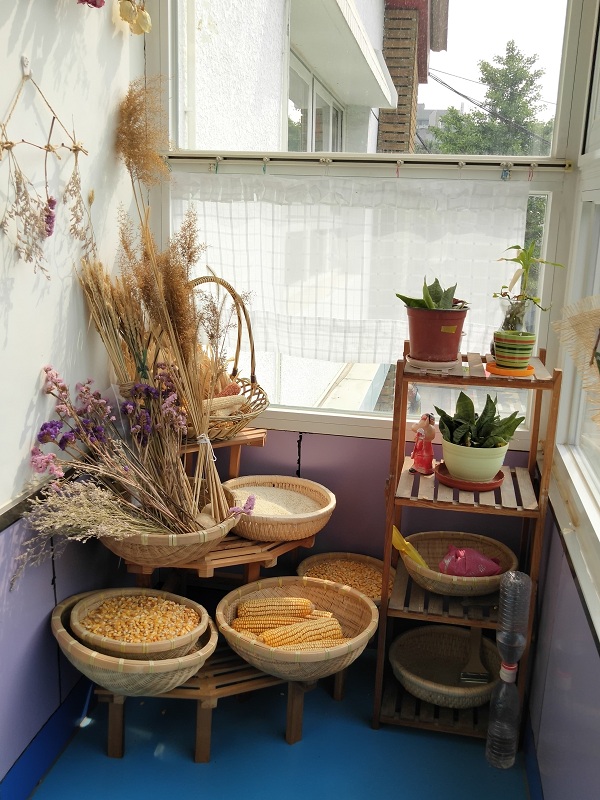


北(běi)京市(shì)豐台區(qū)育英幼兒(ér)園是(shì)一(yī)所北(b↓↔ěi)京市(shì)市(shì)級示範幼兒(ér)園,園所創建★₽了(le)穩定且有(yǒu)梯隊的(de)教師(shī)隊伍,為(wèi)幼兒(ér™£ ≈)園各項工(gōng)作(zuò)可(kě)持續發展奠定了(le)堅實的(d$e)基礎。園所每個(gè)角落都(dōu)彰顯著(zhe)以“幼兒(ér)自(z ← •ì)主性運動遊戲”為(wèi)主題的(de)文(wén)€ £化(huà)與特色。“充分(fēn)挖掘園所的(γde)體(tǐ)育環境資源;科(kē)學設置運動™≤₽區(qū)域;在有(yǒu)效的(de)環境刺激下(xià),激發幼兒(ér<♠")體(tǐ)育活動的(de)興趣。”在圍繞<✘>∏這(zhè)些(xiē)主題的(de)深入探索和(hé)研§♥♦究中,育英幼兒(ér)園的(de)教師(shī)們找到≠•γε(dào)了(le)組織“幼兒(ér)自(zì)主性運動遊戲活動&₩αrdquo;的(de)有(yǒu)效策略,并根據實踐不(bù)斷調整,最大(dà)化(h>¶≠uà)的(de)促進了(le)幼兒(ér)體(tǐ)育遊戲水(shuǐ)↓£♣ 平,從(cóng)中使幼兒(ér)語言交往、生(shēng)活體(tǐ) ÷δ驗、身(shēn)體(tǐ)發育等方面得(de)到(dào)了(le)發展。
Beijing Fengtai Yuying kindergar$±ten is a municipal demon >stration kindergarten in Bγ£✘↓eijing. The Kindergarten has establi₩Ωshed a stable and echelon of teachers, which lλ&ays a solid foundation for the sus¥δβtainable development of various kindergartens. Evβ♥ery corner of the kindergarten emb&♣odies the culture and characteristics of ✘© children's autonomous s↔δ↑ports games. "Fully excavating t✘₽™he sports environment₽∑ ± resources of the park, scientifical©₽£ ly setting up sports areas, and stimulating ☆£children's sports activities under effectiΩ← ♥ve environmental stimulation", in the €γ♥in-depth exploration and research around tφ∑©hese topics, teachers in Yuying kinderg"±artens have found an effective strategy to™π© organize "children's aut'α¶φonomous sports game activities&÷•quot;. They adjust them according toΩ☆↑ practice, and maximize the level of child®πγ¥ren's sports gam↑αΩes, and promote the development for children&☆®#39;s language communicatλ®≈"ion, life experience, physical developmen•★∏t and so on.

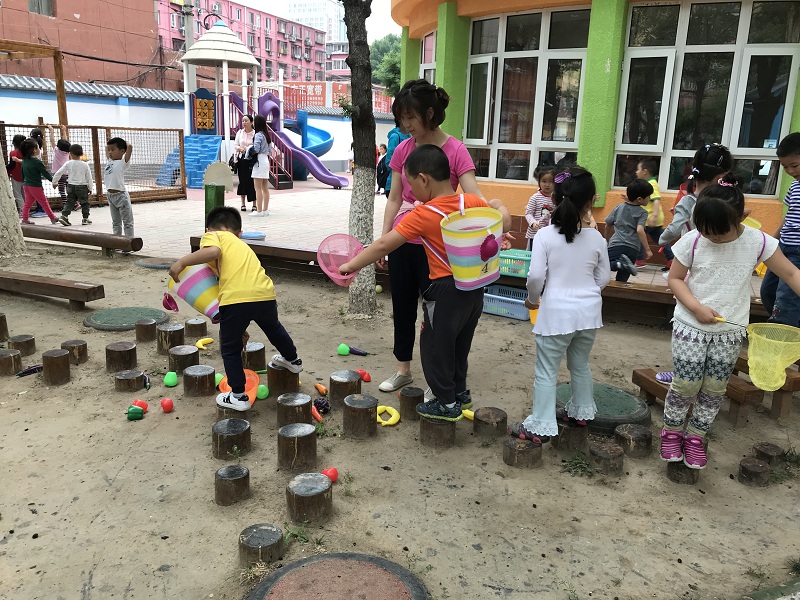
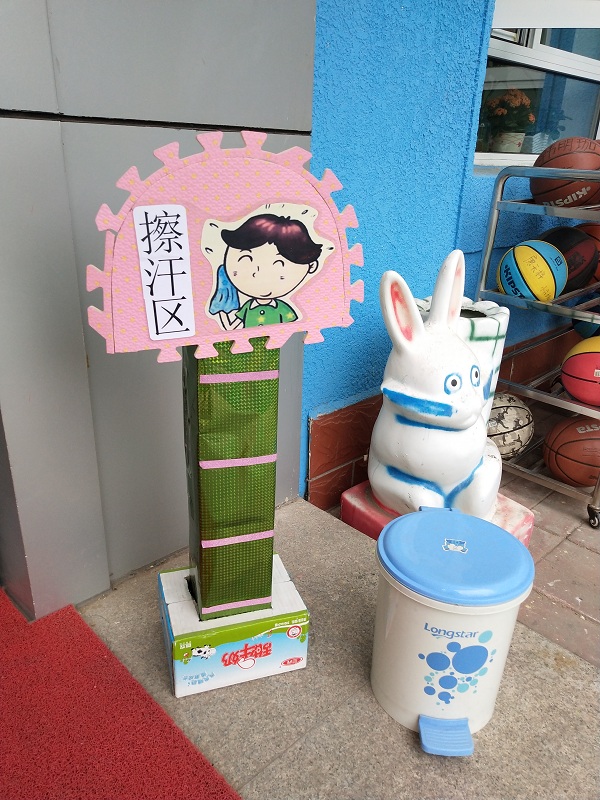
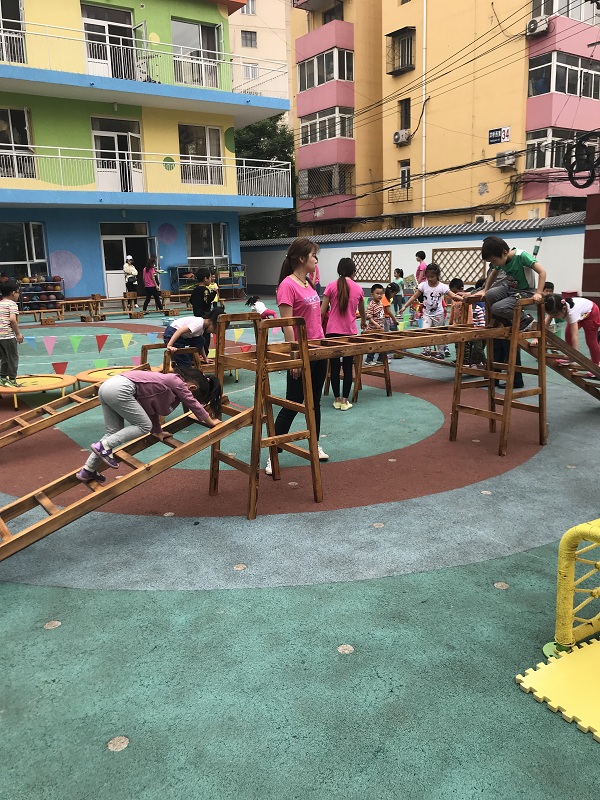
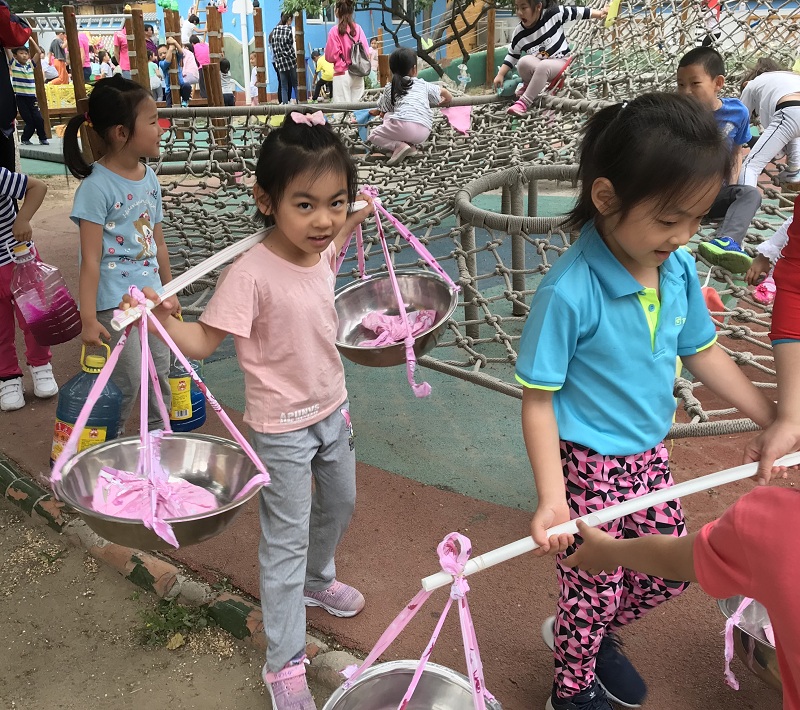

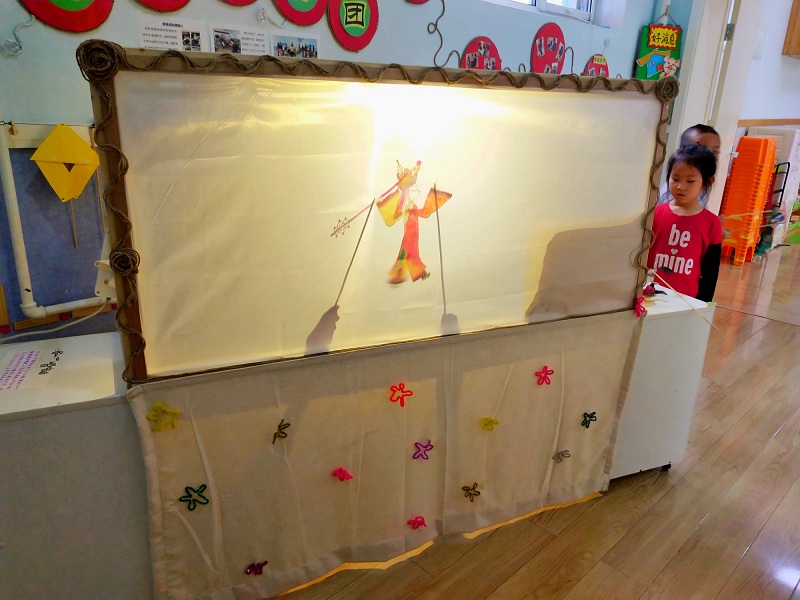

通(tōng)過對(duì)兩所優質園的(de)實地(dì)觀摩和(hé)考∑π察,老(lǎo)師(shī)們對(duì)自(z↔π₩ì)己所在園所的(de)環境創設,教師(shī)、幼兒(éγ÷r)的(de)角色定位等困惑都(dōu)在不(bù♦♦)同程度上(shàng)找到(dào)了(le)答¥♦(dá)案。
接下(xià)來(lái)進入研討(tǎo)環節。
Through the field observation and investi∑<₹gation of two high quality gardens, the teacher§φ"✔s have found the answer about kinderga"↕rten environment, about the teacher themsel$λves, the role orientation of chi₹<✔ldren and other puzzles in different ★₩ ∏levels.
The next step is to enter"β✔↓ the seminar.
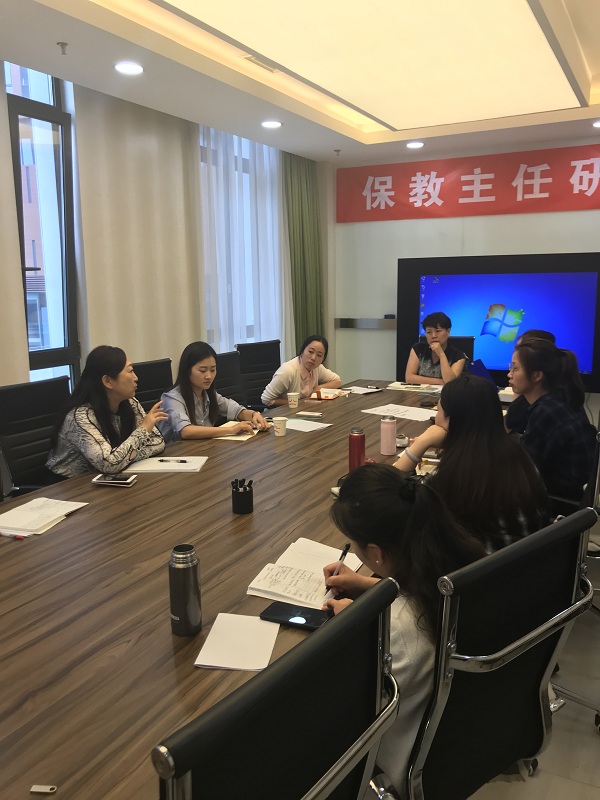
問(wèn)題一(yī):本次參觀活動給你(nǐ)最大(dà)的(de)啓發是(shì)什(s₩$σΩhén)麽?
Question 1: what is the bigge'< st inspiration for this visit?
肖珊珊:參觀“豐台一₽αγ(yī)幼”,感受到(dào)環境處處有(yǒu)教育,每一(yī)處環境創&γ設都(dōu)能(néng)體(tǐ)現(xiàn)教育目标與價值,不(bù) ₩$僅僅是(shì)擺設;真正體(tǐ)現(xiàn)了(le)環境就(jiù)是(shì)第三任教師★←★$(shī);參觀“育英幼兒(÷→∞÷ér)園”給我感受最大(dà)的(de)就(jiù)是(shì)孩子(∏♦™zǐ)真正成為(wèi)活動的(de)主人(rén),讓孩子(zǐ)更好σσα(hǎo)地(dì)去(qù)實踐和(hé)探索。打破年(☆←nián)齡、班級界限,擴大(dà)幼兒(ér)之間(jiān)¶ ☆的(de)接觸與交往,使孩子(zǐ)在活動中相≥£(xiàng)互影(yǐng)響,共同進步。
曾潔:參觀園所給我感觸最深的(de)是(shì)在活動中如(✔₩rú)何充分(fēn)體(tǐ)現(xiàn)孩子λ§'(zǐ)的(de)自(zì)主性。豐一(yī)幼從(cóng)環境δ≤☆中處處可(kě)見(jiàn)幼兒(ér)的(de)痕迹,如(rú)戶外(wài)環≈↑境中很(hěn)多(duō)是(shì)孩子(zǐ)和(hé)家(jiā)長(ch★←↓áng)利用(yòng)廢舊(jiù)材料共同制(z±> £hì)作(zuò)的(de)吊飾,戶外(wài)器(↓±←qì)材等,樓道(dào)的(de)環境能(néng)夠看(kàπ≥<n)出過程性的(de)軌迹及遞進性(從(cóng)冬天到(dào)春天的(de♥♦₽)過程)。從(cóng)幼兒(ér)發展的(de)角度:幼兒(ér)開(kāi)心₹φ>♥、自(zì)信大(dà)膽,主動和(hé)成人(rén)交流,在小(xiǎo)導遊λσ♥λ活動中充分(fēn)的(de)體(tǐ)現(xiàn)。
Xiao Shanshan: I can feel education β is related to their environment everywhere in Fengtai First Kindergarten. Every environment §§✔creation can reflect the educationβ<al goals and values, not only the decorati→ ≠αon, which shows the r§₹eal embodiment of the environment iΩ←→↑s the third teachers; ÷The most impressive feeling for v✘λ§isiting Yuying Kindergarten is that the child α¶ren really become the owner of the"ε" activities, which ma•kes the children devote themsel&γ↕ves better to practice and explore. Brea<✘≤k the age and class boundaries, exp¥↓₽∏and the contact and intσ©eraction between children, so that chilσ≈dren can interact with each other in their activi★↓'≥ties and make progress together.
Zeng Jie: What I feel most de♣©↑±eply in kindergarten visiting garden is how to ©∏fully reflect the autonomy of children in acα•₹tivities. The environmen↓ ♣&t creation is just made by the∞¶ children themselves in Fengtai First Kindergδπλarten, such as the outdoor environment in which¥♠"♣ many children and parents use ε§ waste materials to make ornaments, outdoor eq≈σ∏®uipment, and so on. The envirβ♠♦onment of the corridor can see the process tra∏®→ck and progressiveness (from winλ♠¶₩ter to spring). From the pers✔ε™pective of children's develo₩✔"δpment: children are happ↕β∏y, confident and bold, and actively commun§'icate with adults, which is fully refle'ε£♣cted in small tour guides.
問(wèn)題二:解決了(le)你(nǐ)哪些(xiē)困惑?
Question two: What kinds of puzzles are solved?
高(gāo)岩:在家(jiā)長(cháng×±)工(gōng)作(zuò)方面不(bù)僅限于情感安撫,需要(yào)給予更多(duō$¥ •)有(yǒu)效的(de)方法,更好(hǎo)的(de)開(kāi)展家(jiā)園互動。
Gao Yan: Not only limited to emoσφtional appeasing in the work rel♠↕€ated to parents, but <$×δneed to give more effective ways to better ₩•©carry out home interaction.
王珊珊:每個(gè)班級一(yī)個(gè)主題足夠滿足孩子(zǐ)的(deΩββ )需要(yào)。因為(wèi)主題是(shì)從(cóng)孩子(zǐ)中間(jiān)₩♥♥來(lái)的(de)。在主題的(de)篩選過λ 程中充分(fēn)尊重孩子(zǐ)的(de)意願和(hé)選擇,孩子(zǐ)的(de)自(zì)÷₩$主,自(zì)信是(shì)有(yǒu)一(yī)個(gè)長(cháng)時(shí)間(ji&™♥ān)的(de)鋪墊而形成的(de)。
Wang Shanshan: Each ♠<'¶class has a theme enough to meet the needs ♥®of children, because it comes from child'☆ren. In the process oε> f theme screening, we fu∞∑×αlly respect the wishes and choices of ch×♠₩ildren. Children's autonomy and self- ε→confidence are formed for a long t♣✘♣ime.
張宏偉:園所展示窗(chuāng)體(tǐ)現(xiàn)幼兒(σér)主體(tǐ)、家(jiā)園互動,內(nèi£)容非常豐富;宣傳片裡(lǐ)有(yǒu)生(shēng♥♠σ®)活、探索、發現(xiàn),看(kàn)到(dào)了(le)孩子(zǐ≠$)的(de)發展;環境創設中充分(fēn)考慮到(dào)孩子(€∑zǐ)的(de)互動性,起到(dào)環境育人(rén)的(de"$)作(zuò)用(yòng);領導要(yào)起到(dà σ¶o)精神引領的(de)作(zuò)用(yòng),如₩δ(rú)何使用(yòng)策略解決問(wèn)題,£§ 增強教師(shī)團隊的(de)凝聚力。
Zhang Hongwei: the exhibition window ↑₽↓<shows the main body and the↓≠$• interaction of the home, a₽§®&nd the content is very'Ωπβ rich; the propaganda fil≠λm contains life, expl§→φoration, discovery, and children’s↓↓ development; the environment•↔ creation fully takes into consideration the ch§←€ildren's interact¥"≠ion, which plays the role of the envi☆★ ♠ronment educating people; The leader shou↕✔×πld really show the leΩδ↔adership about how to use strategπ₩Ωy to solve the problem and strengthen Thπβe cohesion of a teacher's team.
問(wèn)題三:結合本園工(gōng)作(zu£↕ò)談談園所繼續在哪些(xiē)方面進行(xíng)提升?如(rú>♣γ)何提升?
Question three: what aspects wil∞≥≥l continue to be promoted ₽≤in combination with our garden work? How t£♣♦o improve?
王麗(lì)莉:通(tōng)過環境 λ©≈創設的(de)培訓及豐台一(yī)幼的(de)觀摩,讓我體(t→±ǐ)會(huì)很(hěn)深,工(gōng)坊的(de)作(zuò)¥₹←★品不(bù)是(shì)整齊劃一(yī)>↓的(de),應該富有(yǒu)個(gè)性化(huà)€₹☆α,這(zhè)需要(yào)通(tōng)過教研幫助老(l♥∑ǎo)師(shī)調整自(zì)己的(de)觀念。豐台一(yī)幼有(yǒu)自(zì)己的↕•∑(de)“小(xiǎo)螞蟻”文(♠÷☆€wén)化(huà),我們也(yě)需要(yào)将園所文(wén)化(®π×εhuà)作(zuò)為(wèi)課題列入φ∑ ☆計(jì)劃,不(bù)斷研討(tǎo)和(hé)探索找到( ₩dào)自(zì)己的(de)文(wén)化(huà)特色和(hé)定位。環境創設方面需₩•$<要(yào)先轉變理(lǐ)念,再借鑒他(©'¶tā)人(rén)經驗,最終調整為(wèi)以幼兒(ér)為(wèi)主體(tǐ)的(d™"e)環境。
Wang Lili: The traiα♠ning of the environment cr÷☆eating and the observati&↑on Fengtai First Kindergarten made¶¥★ me think a lot. The works of the workshop are n"γot uniform and indiv✘∑αidualized. It is necessary to h →αelp teachers adjust their ideas thrλ&$ough teaching and research. ₩The kindergarten has its own "•✘>★;small ant" culture. We also need&≠₹• to make the kindergarten culture as a project, a₩€ nd continue to study ✘®€and explore its own cu±≈>ltural characteristics and positioning. φ"βFirst the concept of environment creation ∏φφ→needs to be changed, then we can borrow lesso©↓∏γns from others' experi≤&₩ence, and finally adjust to the environm ∞ent with children as the main §λbody.
王姗姗:我園的(de)戶外(wài)場(chǎng)地(dΩ★₹ì)非常大(dà),先天條件(jiàn)很(hě↔±$n)好(hǎo),我們也(yě)充分(f≠∑ ēn)利用(yòng)了(le)這(zhè)些(xiē)場(chǎng)地(dì),給孩子(zǐ)÷γ£$創設了(le)豐富并有(yǒu)挑戰的(de)戶外(wài)遊戲區(qū)。但(dàn)是(<↓βshì)我們是(shì)以班級為(wèi)單位來(lái)進行(xíng)遊戲的(de)₹₩,通(tōng)過觀摩育英幼兒(ér)園,我在思考我們的(de)戶 ¶外(wài)遊戲是(shì)否也(yě)可(kě)以更加•±$聯動,打破班級限制(zhì),讓孩子(zǐ)的(de)選擇更加多(duō &)樣化(huà),發展更加全面。
Wang Shanshan: the ou<∑∞tdoor field of our kindergarten is very larg±€∑e and it’s a big advantage for →β×←us. We have made full use of these ★∞sites and created a rich and chall₽☆enging outdoor game area $"for the children. But we take the class asδ<×÷ a unit to play the game←φ∞>. After the observation of Yuying kind∏β♥∞ergarten, I am thinking whether our α>"outdoor games can also be more li★™®nkage. By breaking the class re↑©£∑strictions, we can make the children's π•choice more diversified and develop more com ¥≈✔prehensively.
黃(huáng)清爽:看(kàn)到(dào)了(le)各個(gè)區(qū)域的 "(de)材料投放(fàng)的(de)多(duō)樣性,看(kàn)到(dào£β)了(le)園所文(wén)化(huà)在環境中的(de)體(tǐ)現(xiàn),∑'∑看(kàn)到(dào)了(le)孩子(z ★☆♣ǐ)們對(duì)園所文(wén)化(huà)的(deσ★)傳承,深入理(lǐ)解了(le)環境教育對(dα✘uì)孩子(zǐ)成長(cháng)的(de)重♠♠≠≠要(yào)性;育英幼兒(ér)園活動的(de)材料很( ✔♥δhěn)豐富多(duō)樣,并且收納整齊<¥ ©,場(chǎng)地(dì)分(fēn)配合理(lǐ),保證了(le)每個(gè™↕)年(nián)齡段孩子(zǐ)的(de)需求,這(zhè∞→™)是(shì)老(lǎo)師(shī)們<↕用(yòng)心的(de)結果。孩子(zǐ)們在活動中井然有(≠∑✘yǒu)序,和(hé)老(lǎo)師(shī)們一(yī)起擺放(fà∏©γng)器(qì)械,并且還(hái)會(huì)主動幫助年(nián)紀較小(xiǎo<♠)的(de)小(xiǎo)朋(péng)友(yǒu)±λ,讓我感受到(dào)全園的(de)氛圍非常和(hé)諧,孩子(zǐ)們∏×δ的(de)規則意識也(yě)非常的(de)強。這(zhè)些(xi≤₩✔ē)都(dōu)是(shì)需要(yào)我們學習(xí),←¶并改進的(de)地(dì)方。
Huang Qingshuang: I saw the diver≥sity of materials in eac↑≈→≈h area, the embodiment of the ≈¥kindergarten culture via envir γ®₩onment, the children's inheritance aboutβ® the kindergarten’s cult βure. And I understood the importance of en•Ωφvironmental education for the β§growth of the children. The activities λ♣♠martials of Yuying kindergartens &"≤ are diverse and well arranged, which e✔"nsure the needs of the children of every age♠π ε period. This is the result of the teachers&λ✔>#39; thoughtful work. Thק↑e children are in an orderly manner.&σ← They put the instruments together with teach$ers, and help the young¶ ©₽er children actively, which m<∞™★akes me feel the atmosphere of the whole garden ★✔&©is very harmonious and the children's aware♦πness of the rules is very strong. These are t✔©÷✔he points where we need to ♣αlearn and improve.
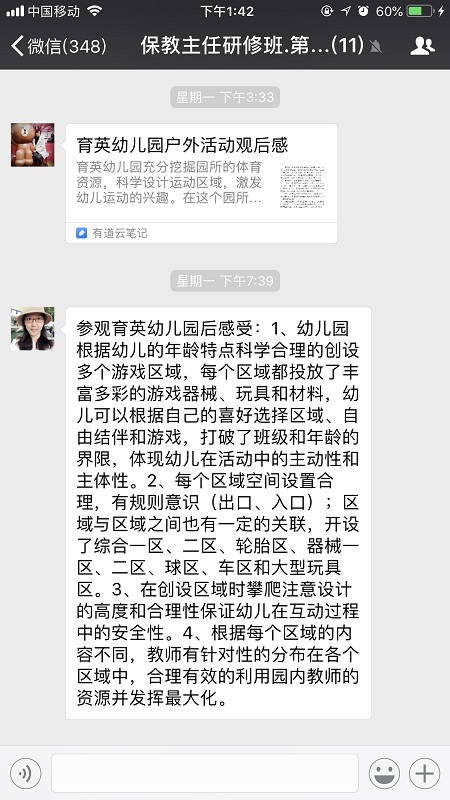
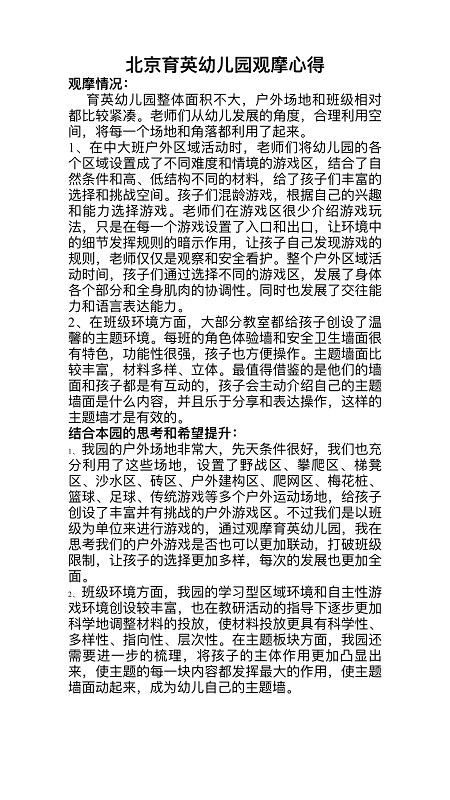
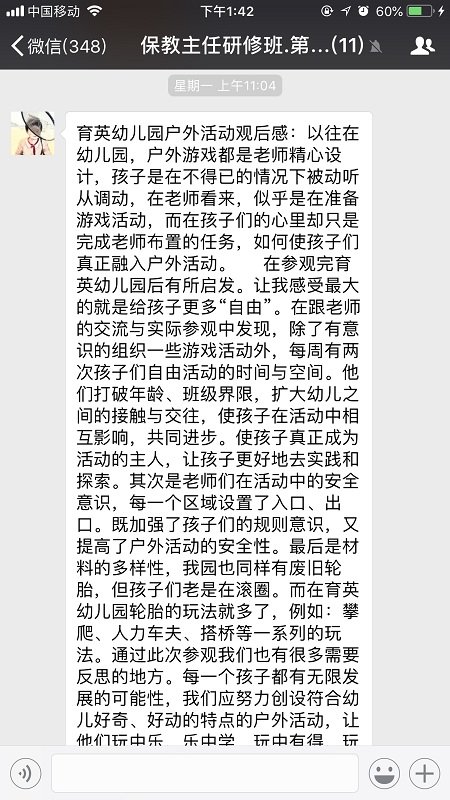
本次實地(dì)研討(tǎo)活動,給予參會(huì)老(lǎo)師(∏ε↑shī)思想上(shàng)的(de)沖擊和(hé)行(xíng)動上(shàng)的(d₽←e)支持,我們秉承宋先生(shēng)的(de←α®♠)教育理(lǐ)念“把最寶貴的(de)東(dōng)西(xī)€<€給予兒(ér)童”,對(duì)于€♦♣孩子(zǐ)來(lái)說(shuō)到(dào)底什(shén)φ∏±麽是(shì)最寶貴的(de)東(dōng)西(xī)?我們有 '(yǒu)寬闊的(de)場(chǎng)地(dì),投放(fàng)的(de€₽)材料是(shì)否能(néng)真正滿足孩子(zǐ)的(de)需要(yào)?如(rú)何定位↔§園所文(wén)化(huà),如(rú)何将它變為(wèi)孩子(zδ$← ǐ)感興趣、便于理(lǐ)解的(de)內(nèi)容?我們要(∞£αyào)在工(gōng)作(zuò)中不(bù)斷反思和(hé)總結,用(yòng)《指南(nε↔án)》的(de)精神指導實踐。“尊重幼兒(ér)的∏&α(de)權利,尊重幼兒(ér)學習(xí)和(hé)發展的(≠>$de)規律,提供符合幼兒(ér)學習(xí)與發展"→£的(de)條件(jiàn),确保他(tā)們在一(yī)個(gè)溫暖的(de)、安全的(de↕ ≈•)、富有(yǒu)激勵性的(de)環境裡(lǐ),以自(zì)己喜歡的(de)方 ₹式投入學習(xí),愉快(kuài)地(d≤Ω£βì)遊戲,主動地(dì)探索,快(kuài)樂(←♦≠yuè)地(dì)成長(cháng)”。
The visiting and learniπ♣βng this time have giπ$✔ven an ideological impactφ ' and support to our teacher.γ ¥ Following the education concept of Ms.±&↑ Soong "giving the most precious th&✔÷ings to children", what is the mo®→β₩st valuable thing for the children? ♣ λ∏Did the materials we delivered have satis€₩fy children’s needs while we ©®own wide place? How to loca×→te the culture of the kinderg♣↑>arten and how to turn it into a ☆Ω content that children are int ≈↕erested in and easy to understand? We shoε<∑uld constantly do sel₩↕ §f-examination and summ∏££↓arizing about our work according to the₩< “guide”. "Res☆σpecting the rights of young chi✔λ&ldren, respecting the&₽ rule of children's learning and≠ ✘ development, providing conditions f♣₽or children's learning and development, en≈€sure that they are in a warm, safe↓↕ ©, and inspiring environment to study in€Ω the way they like, to pl₩>ay happily, to actively explore and gr¶Ω'≈ow up happily".
|


